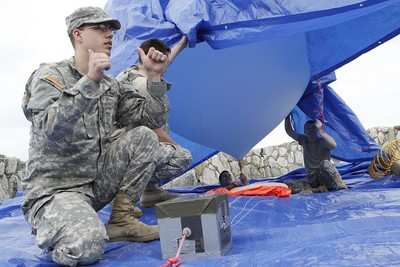Cadets from the Astronomy Club, Amateur Radio Club Participated
In The Second West Point Balloon Satellite Launch On May 13
The pursuit of success and the thrill of a chase was enough to
get a group of exam-weary cadets to conduct a second launch of the
West Point Balloon Satellite May 13. With most of the Corps of
Cadets completing finals or enjoying leave prior to Graduation
Week, six cadets and two officers invested their own time to
explore the edge of space on the final day of the spring
semester.

Comprised of cadets from the Astronomy Club and Amateur Radio
club, a convoy traveled to Sam's Point Preserve, NY, about an hour
outside West Point, and established a launch site at an elevation
of 2,200 feet overlooking Minnewaska State Park. The location was
predetermined by a mathematical model of current wind patterns to
estimate a landing in the vicinity of West Point and away from
water or mountainous terrain. On first look at the rocky platform
and magnificent vista, there was no argument to the "awesome"
factor of choosing Sam's Point for a launch site.
The team included Class of 2013 Cadets Brett Darden, Justin
Vonsik, Robert Glover, Phillip Weigand, Class of 2011 Cadet Anthony
Gonzalez and Class of 2014 Cadet Mike Gotschall; with Maj. Stephen
Hamilton and Maj. Diana Loucks as officers-in-charge. The cadets
kept the balloon covered as they filled it with helium to prevent
heavy wind gusts from taking it too early. The payload, which
included two cameras (one for video and another for still
photography) was examined and tested to ensure it would remain
operational after liftoff.
The telemetry package was also tested so that the balloon's
voyage could be tracked in real time through the Automatic Packet
Reporting System. The package transmitted signals to an ad hoc
network of ham radio operators that run a nationwide communications
utility as a community service. "It's literally a hodgepodge of ham
radio operators and clubs who set up their computers on the network
and that's what we rely on to receive the transmission," said
Hamilton, an Electrical Engineering and Computer Science assistant
professor.

Once the payload was secured to a parachute attached to the
balloon, the team, along with a family of hikers observing the
action, launched the balloon and raced to the vehicles to begin the
pursuit. Movement was easily traced by radio and smart phones
through the APRS tracking device, providing accurate speed,
altitude and location.
Excitement built as the team followed a course that sometimes
seemed destined to touch down in a lake or airport, just to keep
things interesting. Fortunately, this second high-altitude launch
found the team well-rehearsed and they tracked the satellite
throughout its journey and quickly recovered the undamaged payload
at a business complex in Newburgh, NY, about 15 miles from West
Point. The instruments were still cold from their journey to space,
but within minutes, the team was marveling at the hundreds of
stratospheric images and video taken more than 85,000 feet high.
"This launch went smoother, and we had a more manageable balloon
and an improved payload," Vonsik, a physics major, said.
"The main factor that contributed to that was the fact that
everyone knew what they were supposed to do and what to expect,"
Darden added. "Though we lost some time because of the technical
difficulties we had, everything else was done quickly and
efficiently." Darden, an Arts, Philosophy and Literature major, had
no idea what a balloon satellite was before joining the Astronomy
Club. In fact, he joined for the pizza served every Monday. "But
seeing that balloon go up that first time was amazing," Darden
said. "We spent hours working on that satellite."

Loucks, an instructor in the Physics and Nuclear Engineering
Department, described it as a win-win for cadets and research
development at West Point.
"The greatest benefit in my eyes is space education," Loucks
said. "The balloon satellite program allows cadets from all majors
to participate and learn about the many nuances of space technology
and applications within the Army. The engineering process also
occurs in the background and the cadets get instant feedback on
their accomplishments."
The team also has the support of the U.S. Air Force Academy
Aeronautics Department and the Space Club, which has been tracking
the progress on the West Point Balloon Satellite Facebook page.
Collaboration between the two academies was made earlier this year
after the establishment of a ground station here to communicate
with the Air Force Falcon III Satellite in space, involving cadets
from the West Point Small Satellite Research Group and the Amateur
Radio Club.
 ANN's Daily Aero-Linx (04.15.24)
ANN's Daily Aero-Linx (04.15.24) Classic Aero-TV: 'No Other Options' -- The Israeli Air Force's Danny Shapira
Classic Aero-TV: 'No Other Options' -- The Israeli Air Force's Danny Shapira Aero-News: Quote of the Day (04.15.24)
Aero-News: Quote of the Day (04.15.24) Airborne 04.16.24: RV Update, Affordable Flying Expo, Diamond Lil
Airborne 04.16.24: RV Update, Affordable Flying Expo, Diamond Lil ANN's Daily Aero-Term (04.16.24): Chart Supplement US
ANN's Daily Aero-Term (04.16.24): Chart Supplement US





